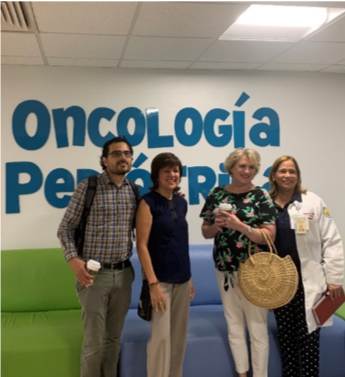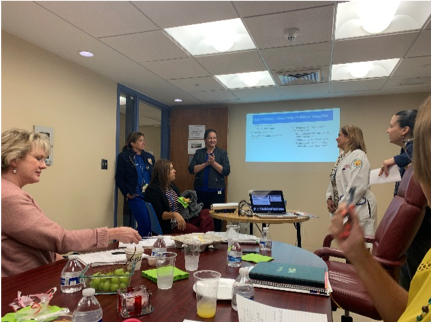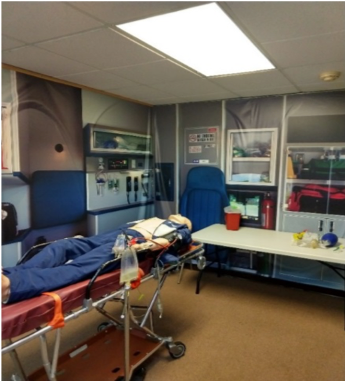A digest of EMSC Program News and Activities
Issue #40 | Aug. 15, 2019
Featured Articles
Dr. Charles Macias to Transition to University Hospitals Rainbow Babies and Children’s Hospital

Charles G. Macias MD, MPH, Executive Director of the EMS for Children Innovation and Improvement Center has transitioned to a new academic and health care system role that will allow an even broader expansion of the EIIC. On August 1, 2019, Macias began a new dual leadership role in the University Hospitals Rainbow enterprise as Chief Quality Officer-UH Rainbow/Vice Chair of Quality and Division Chief of Pediatric Emergency Medicine in Cleveland, Ohio. He will retain his role as Executive Director of the EIIC and PI of the HRSA/EMSC EIIC grant as an adjunct faculty at Baylor College of Medicine, Houston, Texas where the grant has been housed since 2016. UH Rainbow will become a new partner in the EIIC. Additionally, Corrie Chumpitazi MD, MSCR will assume the concurrent role Macias had as site PI for the EIIC at Baylor College of Medicine/Texas Children's Hospital assuming some of the daily operational activities of the EIIC. Given the virtual nature of the national team of experts in the EIIC that span the country's geography to support the EMSC assets, Macias' institutional move will be seamless to the EMSC community but will facilitate further growth of EIIC by drawing a bigger talent pool and workforce and providing more "pediatric readiness" best practices in different regions of the country. Add new email address
The EIIC works to drive quality improvement and improved outcomes, focusing its support on national initiatives that enhance pediatric capabilities in systems for prehospital and emergency department care, disaster preparedness and recovery, trauma, injury prevention, research, all across the entire continuum of emergency care for children. The center works in partnership with the EMS for Children federal program, which is dedicated to improving pediatric outcomes in emergency events by expanding and improving emergency medical services to ensure children and adolescents experiencing physical trauma and critical illness receive appropriate care
EMSC Reauthorization Act Passes House of Representatives
The Emergency Medical Services for Children Program Reauthorization Act of 2019 (H.R. 776) passed in the House of Representatives and the Senate (S.1173), sending it on to the president for signature into law. Sponsored by Representative Peter King (NY), this bill reauthorizes the Emergency Medical Services for Children Program through FY2024, which is a grant program administered by the Health Resources and Services Administration. The EMSC program works to ensure that every child has access to appropriate emergency care regardless of where they live.
The program focuses on improving emergency health care for children who are seriously ill or injured. Providing critical support to emergency departments and EMS agencies across the nation as they work to deliver high-quality, appropriate medical care to children and adolescents.
Click here for look back on the history and impact of the EMSC program.
Pediatric Care Coordination Curriculum, 2nd Edition Released

In early July, the National Resource Center for Patient/Family-Centered Medical Home (NRC PFCMH) and the National Center for Care Coordination Technical Assistance announced the launch of the Pediatric Care Coordination Curriculum, 2nd Edition. Grounded in American Academy of Pediatrics (AAP) policy, the curriculum is designed to build capacity among diverse stakeholders through the following activities:
- Effective implementation of key components of care coordination
- Collaborative communication within inter-professional care teams
- Investment in technology solutions
The curriculum also provides tools to measure care coordination activities and support continuous quality improvement efforts. The curriculum can be used for all populations of children, including those with special health care needs. For more information visit the NRC PFCMH Web site or contact medical_home@aap.org.
The NRC PFCMH is a cooperative agreement between the Maternal and Child Health Bureau (MCHB) of the Health Resources and Services Administration and the AAP. The AAP joined with Catalyst Center (Boston University) and Got Transition (The National Alliance to Advance Adolescent Health) to form a national network of technical assistance resource centers, Advancing Systems of Services for CYSHCN Network. These organizations will develop shared goals and activities to address three main areas to improve outcomes for CYSHCN and their families—health care financing, transitions, and patient/family-centered medical home.
Recognition of Award
Michael Shannon Humanitarian Award

Supported by the American Board of Pediatrics Foundation, the Michael Shannon Humanitarian Award recognizes a pediatric emergency medicine physician who has demonstrated excellence in clinical care, mentoring, didactic and bedside teaching, voluntary service and scholarly activities, and who has the potential to emulate the career accomplishments and personal excellence of the late Dr. Shannon.
Congratulations to Dr. Susan Torrey of Texas Children’s Hospital on being the 2019 recipient. Dr. Torrey’s career in pediatric emergency medicine has included administration, education and clinical care. She now focuses primarily on faculty development, mentoring and global health. In addition to her role in the Section of Emergency Medicine, she is an associate division director for Global HOPE, a TCH initiative to develop pediatric hematology and oncology resources in Africa.
Jim Seidel Distinguished Service Award

Congratulations to Dr. Marianne Gausche-Hill, MD FACEP FAAP, for being the recipient of the Jim Seidel Distinguished Service Award. The Jim Seidel Distinguished Service Award recognizes an individual who has made outstanding contributions to the field of pediatric emergency medicine.
Dr. Gausche-Hill is the Medical Director for Los Angeles County Emergency Medical Services (EMS) Agency, Professor of Clinical Emergency Medicine and Pediatrics at the David Geffen School of Medicine at UCLA and serves as Clinical Faculty at Harbor-UCLA Medical Center in Torrance, CA. She is nationally and internationally known for her work as an EMS researcher and educator, and for her leadership in the field of EMS and pediatric emergency medicine. She is best known for her study of pre-hospital airway management for children published in JAMA 2000 and her work on the National Pediatric Readiness Project published in JAMA- Pediatrics in 2015. She has won numerous national awards for her leadership in emergency medicine, pediatric emergency medicine and EMS. Dr. Gausche-Hill currently serves as a senior editor for the textbook, Rosen’s Emergency Medicine: Concepts and Clinical Practice, and serves on the American Board of Emergency Medicine Board of Directors.
Technological Innovations in Pediatric Emergency Medicine Award

Supported by EBSCO-PEMSoft, The Technological Innovations in Pediatric Emergency Medicine Award recognizes technological innovations in pediatric emergency medicine. Congratulations to Dr. Marion Sills for being honored as the 2019 award recipient.
Dr. Marion Sills., is a Professor of Pediatrics – Emergency Medicine at the University of Colorado School of Medicine, and an attending physician in the emergency department at Children's Hospital Colorado. She received her medical degree from the Johns Hopkins University School of Medicine in 1993 and completed her residency in pediatrics there in 1996. She is board-certified in pediatrics emergency medicine and in pediatrics, and is a member of the Academic Pediatric Association and the American Academy of Pediatrics.
Evidence-based and Evidence-informed Strategies for Child and Adolescent Injury Prevention

Injuries and violence are leading causes of morbidity and mortality among U.S. children and adolescents. These injuries are preventable. Researchers have identified many strategies that are effective in preventing injuries in this population. “Evidence-based and Evidence-informed Strategies for Child and Adolescent Injury Prevention” synthesizes findings from recent systematic reviews conducted or disseminated by five organizations that specialize in evidence-based public health.
- Guide to Community Preventive Services (Community Guide), United States
- Cochrane Collaboration, international consortium
- Campbell Collaboration, Europe-based international collaboration
- Evidence for Practice and Policy Information Centre (EPPI), United Kingdom
- Centre for Reviews and Dissemination (CRD), United Kingdom
Critical Crossroads Toolkit Benefits Hospitals
The Critical Crossroads toolkit is a new resource to help hospital emergency departments better manage and coordinate care for children and adolescents in mental health crisis. You can tailor the resources to your specific needs, patient population, and community.
Anyone who establishes policies and protocols in emergency departments can use this toolkit. This includes:
- hospital administrators
- social workers
- pediatric care coordinators
- physicians and nurses
- mental health providers
Critical Crossroads is a product of a partnership between HRSA's Maternal and Child Health Bureau - Emergency Medical Services for Children Program and Federal Office of Rural Health Policy.
Updated Topic Collection: Responder Safety and Health

Developed by the U.S. Department of Health and Human Services (HHS) Office of the Assistant Secretary for Preparedness and Response (ASPR), this Topic Collection from TRACIE (Technical Resources, Assistance Center, and Information Exchange), provides resources that focus on safety strategies (e.g., preventing fatigue, ensuring the availability and correct use of personal protective equipment) and maintaining behavioral health (e.g., working through stress and preventing/addressing compassion fatigue). Resources are categorized in topics that include Behavioral Health and Resilience; Education and Training; Occupational Safety; Personal Protective Equipment; Plans, Tools, and Templates; Responder Fatigue; and Select Occupational Safety and Health Standards.
Resources are categorized in topics that include:
- Behavioral Health and Resilience
- Education and Training
- Occupational Safety
- Personal Protective Equipment
- Plans, Tools, and Templates
- Responder Fatigue
- Select Occupational Safety and Health Standards
EMSC Pulse PDF
EMSC In Puerto Rico
In early July 2019, the Puerto Rico EMSC Program hosted a site visit that included representatives from the Federal EMSC Program and National EMSC Data Analysis Resource Center (NEDARC). The site visit included meetings with the PR EMSC Program, PR Emergency Medical Services, and the PR EMSC Advisory Committee. Federal partners became familiar with the program’s status and its recovery efforts from Hurricane Maria and Hurricane Irma. EMSC SP Performance Measures remain a priority for PR EMSC Program staff, even though the devastating impact of the storms has redirected some resources.
Members of the PR EMSC team have engaged in many projects to improve emergency medical services for children. We are looking forward to supporting their continuing efforts helping make connections to other program grantees, program resources, and assisting them with site visit recommendations.



Subscribe to the EMSCPulse
Get the EMSCPulse Newsletter delivered to your inbox every month.